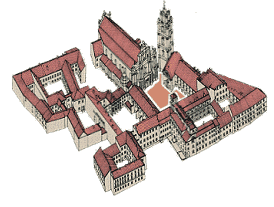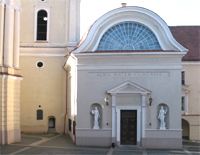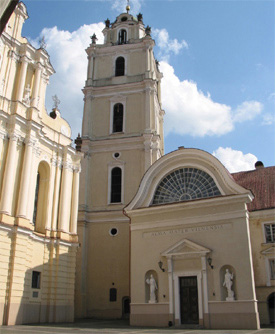|
VILNIUS UNIVERSITY - 425 YEARS |
|
VILNIUS UNIVERSITY architectural ensemble |

|
| The Great Courtyard |
The Great Courtyard
The Great Courtyard is composed of buildings from different
periods, connected via baroque-like expanses to form a dynamic environment.
The north and
west buildings, constructed in the 16th century, are among the oldest
at the Vilnius University. The foundations of the Church of Sts. John were laid in the
14th century, and the bell-tower was erected in the 17th century. The Great Courtyard,
whose parameters have remained constant to this day, was finally completed once the south
building and 'aula' were built in the mid-18th century.
The last significant changes in the architecture
of the Great Courtyard took place after the fires of 1737 and 1749. A third storey
was added to the north and
west buildings of the university, and the
baroque facade of the Church of Sts. John was created at that time. F.Smuglewicz produced a
drawing of the restored Great Courtyard in 1786. In it one can see all three wings of the
courtyard: on the right is the north wing, in the middle - the west wing with the
east tower of the astronomy observatory, and on the left - the south wing with the
academic Theatre Hall and part of the new baroque aula. The same Great Courtyard is
visible, from the other side, in a coloured 1850 lithograph in J.K.Wilczynski's
Vilnius Album. The lofty baroque facade of the Church of Sts. John, the magnificent
bell-tower, and the new classical facade (rebuilt by university architect M.?ulcas in 1810)
of the Small Aula lend the image an air of distinction and stateliness.
Immortalized in the galleries of the Great
Courtyard are the founders, patrons, and celebrated scholars of the university.
Hanging on the north wing of a wall of the complex is the Vilnius University banner:
"Academia et Universitas Societatis Jesu"; on the coloured frescoes of the facade
pilasters - the university coat of arms, and portraits of bishop Walerjan Protasewicz,
military leader K.Chodkewicz, and kings Augustus II the Strong and Stanislas Augustus
Poniatowski. Above the aula facade hangs the inscription: "Alma Mater Vilnensis".
| << Back | Top >> |









